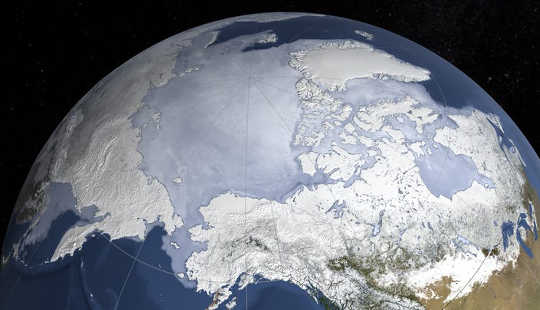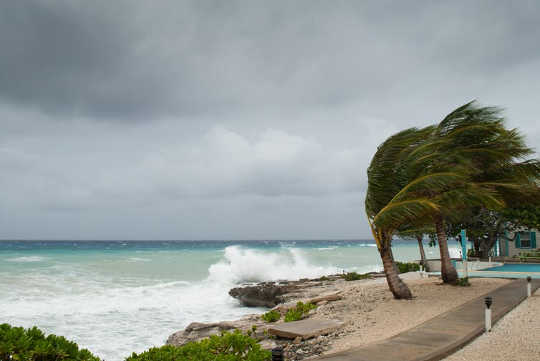
エルローセ/シャッターストック
世界の気候科学者は次のように述べています。人為的な地球温暖化を 1.5 に抑えたいのであれば?おそらくできるでしょう。しかし、我々がどこから出発するかを考えると、それは難しいだろう。
それは、 新しいレポート by the UN’s Intergovernmental Panel on Climate Change (IPCC). The focus on 1.5? is the result of years of international negotiation. Starting in 1994, a central aim of the UN’s climate change efforts (the Framework Convention on Climate Change, or UNFCCC) was to stabilise greenhouse gas concentrations at a level that would “prevent dangerous anthropogenic interference with the climate system”. Much was written on what this meant, particularly the word “dangerous”.
気候変動の負の影響は連続体で発生し、気候変動が危険になる点を定義することは困難で議論の余地があります。 一方、気候変動交渉は、何らかの目標を達成することなく困難である。
Fifteen years later, the UNFCCC’s Copenhagen Accord introduced a 2? target, and its 2015 パリ協定 was even more specific: it “aims to strengthen the global response to the threat of climate change … by holding the increase in … temperature to well below 2? above pre-industrial levels and pursuing efforts to limit the … increase to 1.5?”.
IPCCは、政策を立てるUNFCCCに科学的助言を提供し、IPCC自体は温度目標を決して表明していない。 しかし、5つの「懸念の理由」を用いて気候変動リスクを列挙している。 これには、「検出不能」から「非常に高い」まで評価された「ユニークで脅威のある生態系と文化」(サンゴ礁など)や「極端な気象現象」などの影響が含まれます。 IPCCの最新の(2014) 第5回評価 of the scientific evidence found that at around 1.5? warming there was a transition 中リスクから高リスクへ 脅かされた生態系と文化、そして極端な気象事態のために。 したがって、パリとIPCCの評価の間に一貫性があります。
 気候変動により、いくつかの極端な気象がより一般的になります。 ドリュー・マッカーサー/シャッターストック
気候変動により、いくつかの極端な気象がより一般的になります。 ドリュー・マッカーサー/シャッターストック
The Paris Agreement asked the IPCC to report on the impacts of global warming of 1.5?, and this new publication is the result. Its tone is not “we must avoid 1.5? warming”, as you might think from many commentators, but more “if we want to avoid 1.5? warming, this is what must be done”. The report contrasts the impact of 1.5? and 2? warmings, giving information on what would be gained by the extra effort needed to limit warming to 1.5?.
As the IPCC’s reports are largely based on a critical assessment and synthesis of published scientific papers, many of its latest conclusions are unsurprising. There are many well recognised uncertainties in understanding climate change - for instance, even if we set a course aiming to hit 1.5? (which is mostly determined by future CO? emissions), we could end up hitting, say, 1? or 2? instead. The report provides uncertainty ranges in its estimates and confidence levels, based on expert judgement.
The new report tells us that human activity has already caused about 1? of global warming, while at the present rate of warming (0.2? per decade) we’ll hit 1.5? by about 2040. National pledges made as part of the Paris Agreement still mean we are on course for warming of about 3? by 2100, meaning four of the five “reasons for concern” would then be in the high to very-high risk category.
Achieving the 1.5? target will require anthropogenic CO? emissions to decline by 45% by 2030 (relative to 2010). By 2050, they will need to reach “net zero” - any further CO? emissions due to human activity would then have to be matched by 意図的な除去 of CO? already in the atmosphere, including by planting trees. Net zero would have to occur by around 2075 to meet a 2? target.
 タイの植林プロジェクト。 ソマレルク・ウィタヤナント/シャッターストック
タイの植林プロジェクト。 ソマレルク・ウィタヤナント/シャッターストック
Many illustrations are given for the difference between 1.5? and 2? worlds. At 1.5?, summertime Arctic sea ice is projected to disappear once per century, compared to once per decade at 2?; 8% of plants that have been studied would lose half their climatically-suitable area, compared to 16%; sea level rise would be 10cm less (with 10m fewer people impacted at today’s population levels); and while coral reefs might decline by a further 80% at 1.5?, they could virtually disappear at 2?.
The report identifies various routes by which emissions cuts would limit warming to 1.5?; each makes assumptions about future changes in, for example, economic strategy, population growth and the rate at which low carbon energy is adopted. The IPCC recognises the challenges are “unprecedented in scale” but notes, for example, “the feasibility of solar energy, wind energy and electricity storage mechanisms have substantially improved over the past few years”.
The report is sensitive to the fact that changes required to meet 1.5? must be consistent with the UN’s wider 持続可能な開発目標。 気候変動を制限することで、健康、清潔なエネルギー、都市と海洋に関連する目標を達成するのに役立ちます。 しかし、慎重に管理されなければ、他者(貧困、飢餓、水、エネルギーアクセス)に悪影響を与える可能性があります。
だから次は? もちろん、結論は多くのレベルで広く議論されるだろうが、12月初めにポーランドのカトヴィツェで開催される次回会合で、UNFCCCの対応に目が向いている。![]()
著者について
Regiusの気象・気候科学教授Keith Shine氏は、 レディング大学
この記事はから再公開されます 会話 クリエイティブコモンズライセンスの下で 読む 原著.
関連書籍
at InnerSelfMarketとAmazon






















